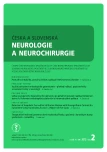Visual Functions in Premature Children with Perinatal Brain Injury
Authors:
D. Liláková 1; D. Hejcmanová 1; J. Jakubec 2; E. Rencová 1
Authors‘ workplace:
LF UK a FN Hradec Králové
Oční klinika
1; LF UK a FN Hradec Králové
Neurochirurgická klinika
2
Published in:
Cesk Slov Neurol N 2012; 75/108(2): 218-221
Category:
Short Communication
Overview
The aim of this research is to evaluate visual functions in premature children who have suffered perinatal brain injury. This study includes children with intraventricular haemorrhage, periventricular leukomalatia, brain atrophy and posthaemorrhagic hydrocephalus, who required surgery. In addition to the general assessment, the following parameters were also evaluated during ophthalmology examination: visual acuity, refractive errors, strabismus. Only 35.4% of children had normal visual acuity. Refractive errors were identified in 55.8% of patients, hypermetropy prevailed (85.7% of all children with refractive disorders). Strabismus was found in 47.9% of children. These results suggest that premature children with brain injury should have regular ophthalmology assessment with early correction of their visual defects.
Key words:
premature children – posthemorrhagic hydrocephalus – periventricular leukomalatia – intraventricular haemorrhage – visual functions
Sources
1. Jacobson L, Dutton G. Periventricular leukomalacia: an important cause of visual and ocular motility dysfunction in children. Surv Ophthalmol 2000; 45(1): 1–13.
2. Pike MG, Holmström G, de Vries LS. Patterns of visual impairment associated with lesions of the preterm infant brain. Dev Med Child Neurol 1994; 36(10): 849–862.
3. Phillips J, Christiansen SP, Ware G, Landers S, Kirby RS. Ocular morbidity in very low birth-weight infants with intraventricular hemorrhage. Am J Ophthalmol 1997; 123(2): 218–223.
4. Cinalli G, Maixner WJ, Sainte-Rose C. Pediatric Hydrocephalus. 1st ed. Milan: Springer Verlag 2004.
5. Jacobson L, Ygge J, Flodmark O. Visual and perceptual characteristics, ocular motility and strabismus in children with periventricular leukomalacia. Strabismus 2002; 10(2): 179–183.
6. Spierer A, Royzman Z, Kuint J. Visual acuity in premature infants. Ophthalmologica 2004; 218(6): 397–401.
7. Saunders KJ, McCulloch DL, Shepherd AJ. Emmetropisation following preterm birth. Br J Ophthalmol 2002; 86(9): 1035–1040.
8. Dutton G. Congenital disorders of the optic nerve: excavations and hypoplasia. Eye 2004; 18(11): 1038–1048.
9. Denne C, Kasmann-Kellner B, Ruprecht KW. Prevalence of optic atrophy and associated ocular and systemic diseases in a department of paediatric ophthalmology. Klin Monatsbl Augenheilkd 2003; 220(11): 767–773.
10. Huo R, Burden S, Hoyt C. Chronic visual impairment in children: etiology, prognosis, and associated neurological defects. Br J Ophthalmol 1999; 83(6): 670–675.
Labels
Paediatric neurology Neurosurgery NeurologyArticle was published in
Czech and Slovak Neurology and Neurosurgery

2012 Issue 2
Most read in this issue
- The Use of Percutaneous Endoscopic Gastrostomy – Overview of Indications, Description of the Technique and Current Trends in Neurology
- Postural Instability, Gait Disorders and Falls in Parkinson’s Disease
- The Algorithm of CSF Examination according to the Reccomendation of the Committee of CSF and Neuroimmunology of the Czech Neurological Society
- Obstructive Sleep Apnoe and CPAP – is it Reasonable to Solve Nasal Patency?
